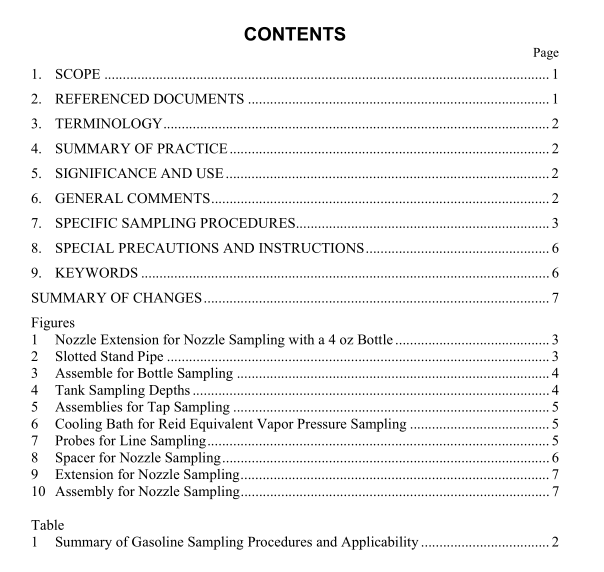API MPMS 8.4 pdf download

API MPMS 8.4 pdf download Manual of Petroleum Measurement Standards Chapter 8—Sampling Section 4—Standard Practice for Sampling and Handling of Fuels for Volatility Measurement
4. Summary of Practice
4.1 It is necessary that the samples be representative of the fuel in question. The basic principle of each sampling procedure involves obtaining a sample in such a manner and from such locations in the tank or other container that the sample will be representative of the fuel. A summary of the sampling procedures and their application is presented in Table 1. Each procedure is suitable for sampling a material under definite storage, transportation, or container conditions. The precau- tions required to ensure the representative character of the samples are numerous and depend upon the tank, carrier, container, or line from which the sample is being obtained, the type and cleanliness of the sample container, and the sampling procedure that is to be used.
5. Significance and Use
5.1 The dry vapor pressure equivalent (DVPE) of volatile motor fuels is regulated by federal and state air pollution control agencies. In order to meet the letter of these regula- tions, it is necessary to sample, handle, and test these products in a very precise manner. 6. General Comments
6.1 Sample Containers:
6.1.1 Sample containers are clear or brown glass bottles, fluorinated high-density polyethylene bottles, or metal cans. The clear glass bottle is advantageous because it is easily examined visually for cleanliness, and also makes visual inspection of the sample for free water or solid impurities possible. The brown glass bottle affords some protection from light. The only cans acceptable are those with the seams soldered on the exterior surface.
6.1.2 Cork stoppers, or screw caps of plastic or metal, are used for glass bottles; screw caps with inserted seals only are used for cans to provide a vapor-tight closure seal. Corks must be of good quality, clean, and free from holes and loose bits of cork. Never use rubber stoppers. Contact ofthe sample with the cork can be prevented by wrapping tin or aluminum foil around the cork before forcing it into the bottle. Screw caps must be protected by a cork disk faced with tin or aluminum foil, an inverted cone polyseal or other material that will not affect petroleum or petroleum products. The fluorinated bottles are supplied with polypropylene screw caps. 6.1.3 Sample size is dictated by the test method to be used. One litre (32 oz) bottles or cans are generally used for manual vapor pressure testing. Some vapor pressure methods may allow a smaller sample size to be taken, such as in a 125 mL (4 oz) bottle. See Fig. 1.
6.1.4 All sample containers must be absolutely clean and free of foreign matter. Before reusing a container, wash it with strong soap solution, rinse it thoroughly with tap water, and finally with distilled water. Dry completely and stopper, or cap, the container immediately. 6.2 Sampling Apparatus—Sampling apparatus is described in detail under each ofthe specific sampling procedures. Clean, dry, and free all sampling apparatus from any substance that might contaminate the material. If necessary, use the clean procedure described in 6.4.
6.3 Time and Place ofSampling:
6.3.1 Storage Tanks—When loading or discharging fuels, take samples from both shipping and receiving tanks, and from the pipelines if required.
6.3.2 Ship or Barge Tanks—Sample each product after the vessel is loaded or just before unloading. 6.3.3 Tank Cars—Sample the product after the car is loaded or just before unloading. N OTE 1—Time, place, and other details of sampling not covered in this practice are normally determined by contractual agreement or regulatory requirements.
6.4 Obtaining Samples:
6.4.1 Directions for sampling cannot be made explicit enough to cover all cases. Extreme care and good judgment are necessary to ensure samples that represent the general charac- ter and average condition of the material. Use lint-free wiping cloths to prevent contaminating samples.









